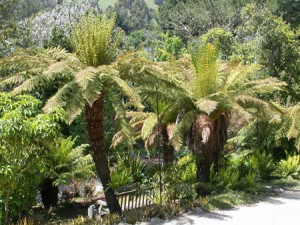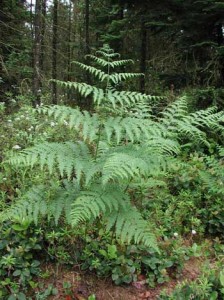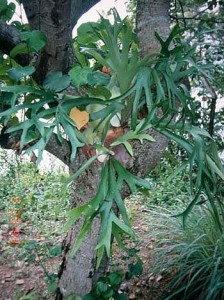Raven 7th, p. 389-398; 8th, p. 417-419
Introduction
 There are approximately 10,000 species ferns. They are mostly homosporous, but there are a some which are heterosporous. They are most common and diversified in the tropics, but are also plentiful in temperate regions. They have creeping or erect rhizomes, and often large leaves (fronds). Here you can see some tree ferns (taken in a botanical garden in California).
There are approximately 10,000 species ferns. They are mostly homosporous, but there are a some which are heterosporous. They are most common and diversified in the tropics, but are also plentiful in temperate regions. They have creeping or erect rhizomes, and often large leaves (fronds). Here you can see some tree ferns (taken in a botanical garden in California).
This is a staghorn fern which grows as an epiphyte (growing on another plant).
 This is Pteridium aquilinum (bracken fern). It contains carcinogenic chemicals in it and has caused poisoning in livestock. This is one leaf. Ferns commonly have compound leaves (leaves with many leaflets). Sporangia are borne on the fronds and grouped together into sori, which may or may not be protected by a membrane called the indusium. The sporangia and accessory structures (or lack of them) are important taxonomic features used to identify the many species. Ferns vary in size from the minute floating forms such as Azolla to the very large (up to 20m tall) tree ferns found in tropical and subtropical areas. The habitat of ferns is generally moist, but may vary from aquatic to xeric.
This is Pteridium aquilinum (bracken fern). It contains carcinogenic chemicals in it and has caused poisoning in livestock. This is one leaf. Ferns commonly have compound leaves (leaves with many leaflets). Sporangia are borne on the fronds and grouped together into sori, which may or may not be protected by a membrane called the indusium. The sporangia and accessory structures (or lack of them) are important taxonomic features used to identify the many species. Ferns vary in size from the minute floating forms such as Azolla to the very large (up to 20m tall) tree ferns found in tropical and subtropical areas. The habitat of ferns is generally moist, but may vary from aquatic to xeric.
In this section we will look at the characteristic structures of the ferns and the different stages in the fern’s life history.

